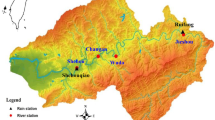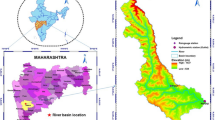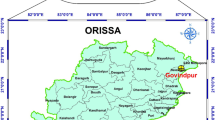Abstract
Accurate real-time forecasts of river stages can serve as a reference for flood evacuation to minimize losses and casualties. Machine learning has been widely used for river stage forecasting because of its simple modeling and quick computation. However, many machine learning models have drawbacks such as excessive learning time, difficult evaluation of input variables, and lack of explanatory capacity, which limit their performance as practical tools. To overcome these drawbacks, this study employs multiple additive regression trees (MART) for river stage forecasting. Three MART models are proposed, namely the original MART model, the real-time MART model, and the naïve MART model, with different considerations of model training and error correction. Model training and testing were conducted based on the rainfall and river stage data for 16 typhoon events between 2005 and 2009 in the Bazhang River Basin in Taiwan. In the training process, variables are automatically selected by the MART models which reasonably describes the mechanism of flood transportation. The testing results show that all three models can reasonably forecast the river stages with a three-hour lead-time. Compared with the original MART, the real-time MART performs better in describing overall river stage variations, whereas the naïve MART is more accurate in the prediction of peak river stages. The proposed MART models are efficient and accurate and can thus serve as practical tools for flash flood early warning.





Similar content being viewed by others
References
Abeare SM (2009) Comparisons of boosted regression tree, GLM and GAM performance the standardization of Yellowfin tuna catch-rate data from the Gulf of Mexico Lonline fishery, MS Thesis, Department of Oceanography and Coastal Sciences, Louisiana State University, Louisiana
Aggarwal SK, Goel A, Singh VP (2012) Stage and discharge forecasting by SVM and ANN techniques. Water Resour Manag 26:3705–3724
ASCE Task Committee (2000) Artificial neural networks in hydrology. I: Preliminary concepts. J Hydrol Eng 5:115–123
Breiman L, Friedman JH, Olshen R, Stone C (1984) Classification and regression trees. Wadsworth: Pacific Grove, CA: Wadsworth
British Broadcasting Corporation (2012) Russia in day of mourning for Krasnodar flood deaths. https://www.bbc.com/news/world-europe-18758895. Accessed 19 June 2019
Carmeron D, Kneale P, See L (2002) An evaluation of a traditional and neural net modeling approach to flood forecasting for an upland catchment. Hydrol Process 16:1033–1046
Chou JS, Chiu CK, Farfoura M, Al-Taharwa I (2011) Optimizing the prediction accuracy of concrete compressive strength based on a comparison of data-mining techniques. J Comput Civ Eng 25(3):242–253
CWB (2019) Observation Data Inquire System. https://e-service.cwb.gov.tw/HistoryDataQuery. Accessed 26 June 2019
Deseret News (2015) 16, possibly 20 die in devastating southern Utah flash floods. https://www.deseretnews.com/article/865636814/10-bodies-recovered-in-Hildale-flash-flood-as-search-continues-for-3-more.html. Accessed 19 June, 2019
Dibike YB, Velickov S, Solomatine D, Abbott MB (1998) Model induction with support vector machines: introduction and applications. J Comput Civ Eng 15(3):208–216
Dumais ST (1998) Using SVMs for text categorization. IEEE Intell Syst: Trends Controversies 13(4)
Elish MO (2009) Improved estimation of software project effort using multiple additive regression trees. Expert Syst Appl 36:10774–10778
Freund Y, Schapire R (1996) Experiments with a new boosting algorithm. In machine learning. Proceedings of the thirteenth international conference, Morgan Kaufmann: San Francisco, CA. 148–156
Friedman JH, Meulman JJ (2003) Multiple additive regression trees with application in epidemiology. Statist Med 22:1365–1381
Ghorbani MA, Zadeh HA, Isazadeh M, Terzi O (2016) A comparative study of artificial neural network (MLP, RBF) and support vector machine models for river flow prediction. Environ Earth Sci 75:476
Ghorbani MA, Khatibi R, Karimi V, Yaseen ZM, Zounemat-Kermani M (2018) Learning from multiple models using artificial intelligence to improve model prediction accuracies: application to river flows. Water Resour Manag 32:4201–4215
Gulati P, Gupta K (2017) Intrusion detection system using gradient boosted trees for VANETs. Int J Res Appl Sci Eng Technol 5(8):482–488
Imrie CE, Durucan S, Korre A (2000) River flow prediction using artificial neural networks: generalization beyond the calibration range. J Hydrol 233(1–4):138–153
Iorgulescu I, Beven KJ (2004) Nonparametric direct mapping of rainfall–runoff relationships: an alternative approach to data analysis and modeling? Water Resour Res 40:W08403
Liu J, Wu C (2017) A gradient-boosting decision-tree approach for firm failure prediction: an empirical model evaluation of Chinese listed companies. J Risk Model Validat 11(2):43–64
Makwana JJ, Tiwari MK (2014) Intermittent streamflow forecasting and extreme event modelling using wavelet based artificial neural networks. Water Resour Manag 28:4857–4873
Mao H, Meng J, Ji F, Zhang Q, Fang H (2019) Comparison of machine learning regression algorithms for cotton leaf area index retrieval using Sentinel-2 spectral bands. Appl Sci 9:1459–1483
Martin MP, Seen DL, Boulonne L, Jolivet C, Nair KM, Bourgeon G, Arrouays D (2009) Optimizing pedotransfer functions for estimating soil bulk density using boosted regression tree. Soil Sci Soc Am J 73:485–493
Mosavi A, Ozturk P, Chau K (2018) Flood prediction using machine learning models: literature review. Water 10:1536–1575
Pal M, Goel A (2007) Prediction of end-depth-ratio and discharge in trapezoidal shaped channels using support vector machines. Water Resour Manag 21:1763–1780
Seo Y, Kim S, Kisi O, Singh VP, Parasuraman K (2016) River stage forecasting using wavelet packet decomposition and machine learning models. Water Resour Manag 30:4011–4035
Shin Y (2015) Application of boosting regression trees to preliminary cost estimation in building construction projects. Comput Intel Neurosc 149702
Srinivasulu S, Jain A (2009) River flow prediction using an integrated approach. J Hydrol Eng 14(1):75–83
The Irish Times (2018) Italian flash flood leaves at least 11 hikers dead. https://www.irishtimes.com/news/world/europe/italian-flash-flood-leaves-at-least-11-hikers-dead-1.3602500. Accessed 19 June, 2019
Thirumalaiah K, Deo MC (1998) River stage forecasting using artificial neural networks. J Hydrol Eng 3(1):26–32
Vapnik VN (1995) The nature of statistical learning theory. Springer, New York
Wang WC, Chau KW, Cheng CT, Qiu LA (2009) Comparison of performance of several artificial intelligence methods for forecasting monthly discharge time series. J Hydrol 374:194–306
WRA (2019) Hydrological Information Integration Service System. https://gweb.wra.gov.tw/HydroInfo. Accessed 26 June 2019
Wu JS, Jun H, Annambhotla S, Bryant S (2005) Artificial neural networks for forecasting watershed runoff and stream flows. J Hydrol Eng 10(3):216–222
Yang S, Wu J, Du Y, He Y, Chen X (2017) Ensemble learning for short-term traffic prediction based on gradient boosting machine. J Sensors 7074143:1–15
Zhou ZH (2012) Ensemble methods: foundations and algorithms. Chapman and Hall/CRC, New York
Acknowledgements
This research was partially funded by the Ministry of Science and Technology (grant no. MOST 108-2625-M-006-008 and MOST 108-2119-M-006-005). The authors would like to thank the Central Weather Bureau, the Water Resources Agency, and the National Science and Technology Center for Disaster Reduction for providing research data.
Author information
Authors and Affiliations
Corresponding author
Ethics declarations
Conflicts of Interest
None.
Additional information
Publisher’s Note
Springer Nature remains neutral with regard to jurisdictional claims in published maps and institutional affiliations.
Rights and permissions
About this article
Cite this article
Fu, JC., Huang, HY., Jang, JH. et al. River Stage Forecasting Using Multiple Additive Regression Trees. Water Resour Manage 33, 4491–4507 (2019). https://doi.org/10.1007/s11269-019-02357-x
Received:
Accepted:
Published:
Issue Date:
DOI: https://doi.org/10.1007/s11269-019-02357-x




